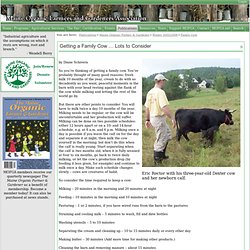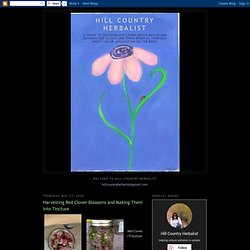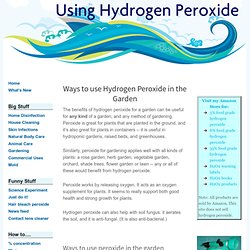

Plant Identification. Seed Banks. Shrooms. Permaculture. Healthy and responsible farming - Health. Barley sprout superfood for livestock. Getting a Family Cow … Lots to Consider. By Diane Schivera So you’re thinking of getting a family cow.

You’ve probably thought of many good reasons: fresh milk 10 months of the year, cream to do with as decadently as you want, peaceful moments in the barn with your head resting against the flank of the cow while milking and letting the rest of the world go by. But there are other points to consider. You will have to milk twice a day 10 months of the year. Milking needs to be regular, or the cow will be uncomfortable and her production will suffer. So consider the time required to keep a cow: Milking – 20 minutes in the morning and 20 minutes at night Feeding – 10 minutes in the morning and 10 minutes at night Pasturing – 1 or 2 minutes, if you have wired runs from the barn to the pastures Straining and cooling milk – 5 minutes to wash, fill and date bottles Washing utensils – 5 to 10 minutes Separating the cream and cleaning up – 10 to 15 minutes daily or every other day Cleaning the barn and removing manure – about 15 minutes Feeding.
Raise Small-breed Milk Cows. In 2006, Pat Schout and his wife, Elia, began homesteading in east-central Illinois.

They wanted to raise their own food, including dairy products. They considered a milk cow, but didn’t know if they’d have enough pasture for a full-size cow and weren’t sure if they could manage all the milk a single cow can produce. A neighbor had discussed the option of small-breed beef cattle, and that gave the Schouts the idea to raise their own small-breed dairy cattle. They started with Jerseys (because of the high butterfat content of their milk) and are now working toward breeding miniature Holsteins.
Breeds Information. Agriculture. Animal & Veterinary. Development & Approval Process New Animal Drug Applications, Electronic Submissions, User Fees, Genetic Engineering, Minor Use/Minor Species, Aquaculture, Food Additive Petitions Guidance, Compliance & Enforcement.

Sheeps. Goats. Health and well being of grazing livestock. Horticulture. True Farmers. Gardening. Rabbits. Greenhouse & Gardening. Cold Frame Gardening. Gardening. Houseplants.
Salmon Watch. True Farmers. Organic. Supply. Irrigation. Homesteading Animals. Homestead Planning & Design. Homesteading Resources. Free Ebooks: Homesteading & Related. Local Farming. Farming. Seed and supply. Fertilizer. AGRICULTURE & PLANTS. Food & Agriculture. Conventional Agriculture Problems. Arduino Assisted Gardening. FARMING: Growing Food & Raising Animals. Homesteading Animals. Gardening Supplies. GARDENING: GROWING FOOD PLANTS & HERBS. Gardening. Gardening. Growing Fruit. Growing Vegetables.
Gardens Delight. Homesteading Garden. Shrooms. Garden & Horticulture. Gardening. Seedlings. Planting. Home and Gardening. Guerilla Gardening. Planning. Garden & Horticulture. Homsteding and Gardening, Farming and Livestock. Gardening. Aquaponics. Rain Gardens. Cold Frame Gardening. Gardening In Style, do it yourself, or with great products.
Potato Towers. Plants. Medicinal Uses of Bee Balm. Bee Balm is a plant that was used often, both medicinally and as a beverage by American Indians and by the European settlers in America.

Oswego Tea, made from the leaves of the plant, was a staple in households during colonial times after the settlers lost access to English teas after the Boston Tea Party. Can Ginger & Water Beat Out The Multi-Billion Dollar Acid Blockers? Did you know that the multi-billion drug category known as “acid blockers,” despite being used by millions around the world daily, may not work as well as the humble ginger plant in relieving symptoms of indigestion and heartburn?

Ginger is a spice, a food, and has been used as a medicine safely for millennia by a wide range of world cultures. Research on the health benefits of ginger is simply staggering in its depth and breadth. In fact, the health benefits of ginger have been studied extensively for over 100 health conditions or symptoms, making it one of the world’s most versatile, evidence-based remedies. The biomedical literature on acid blockers, on the other hand, is rife with examples of the many adverse health effects that come with blocking stomach acid production with xenobiotic, patented drugs, i.e.proton pump inhibitors and H2 antagonists.
The list of 30+ harms is extensive, but here are a few of the most well-established adverse effects you may not be aware of: Diarrhea. Harvesting Red Clover Blossoms & Making Them Into Tincture. Red Clover (Trifolium pratense)typically doesn't grow in Texas, but it was growing on Maypop Farms.

The blossoms are edible and have a neutral, sweet, and satisfying taste. They have an affinity for the salivary glands causing slight stimulation, which is helpful in quenching thirst (Wood 1997). The flowers can be dried or used fresh to make an herbal tea infusion. It's long been considered a blood cleanser and can be used to support the reproductive system and the liver. Since it works well in assisting detoxify the body, it has long been recommended to drink the tea in an effort to address troubled skin. How to Make Essential Oils From Rosemary Leaves. Ways to use Hydrogen Peroxide in the Garden. The benefits of hydrogen peroxide for a garden can be useful for any kind of a garden, and any method of gardening.

Peroxide is great for plants that are planted in the ground, and it’s also great for plants in containers -- it is useful in hydroponic gardens, raised beds, and greenhouses. Similarly, peroxide for gardening applies well with all kinds of plants: a rose garden, herb garden, vegetable garden, orchard, shade trees, flower garden or lawn -- any or all of these would benefit from hydrogen peroxide. Peroxide works by releasing oxygen. It acts as an oxygen supplement for plants. It seems to really support both good health and strong growth for plants.
Hydrogen peroxide can also help with soil fungus: it aerates the soil, and it is anti-fungal. Ways to use peroxide in the garden General fertilizer, either in plant water or sprayed on foliage. How much peroxide to use in the garden…. Making, Oils, Salves, Teas, Etc.